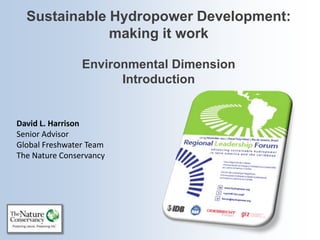
David Harrison, The Nature Conservancy
- 1. Sustainable Hydropower Development: making it work Environmental Dimension Introduction David L. Harrison Senior Advisor Global Freshwater Team The Nature Conservancy
- 2. Environmental Issues of Potential Concern Dams and diversion works can potentially alter the basic environmental conditions which are the foundation for healthy river ecosystems •Direct footprint of physical works and reservoir inundation •Indirect effect of roads, transmission • Altered flow patterns •Sediment and nutrient trapping • Water quality •Connectivity: •Barriers to migration up and down the river •Broken connection to flow in and out of floodplains •Species composition: •Invasive species
- 4. P-19 Biodiversity & Invasive Species (page 90, Protocol) Assessment Guidance Biodiversity issues may include, for example: loss of habitat; fish migration barriers; loss of spawning grounds; loss of habitat connectivity; loss or declines in important food chain species; loss of wetlands; poaching, hunting or over-exploitation of significant species; introduction of weed or pest species; etc. Measures to protect or enhance biodiversity examples include: catchment protection, creation of reserves or protected areas, habitat conservation and improvement, species management plans, translocations, habitat rehabilitation, new habitat creation, managed flow releases, etc. Measures to address passage of aquatic species examples include: fish ladders, fish elevators, catch and release programs, fish hatcheries, re-stocking programs, mechanisms for diversion away from turbines for downstream passage, assisted cues (water chemistry, operational conditions), choice of turbine design, etc.
- 5. P-23 Downstream Flow Regimes (page 98-99 Protocol) SCORE 3 Management: Plans and processes for delivery of downstream flow regimes have been developed that include the flow objectives; the magnitude, range and variability of the flow regimes; the locations at which flows will be verified; and ongoing monitoring… Assessment Guidance Downstream flow regimes might be specified for different components and stages of projects in a manner such as, for example: minimum flows in part of certain seasons, maximum flows in part of certain seasons, or specific flow events such as a flushing flow or a flood intended to inundate flood plains. Individual countries may have laws specifying downstream flow requirements; in such circumstances it will be necessary to see how social, economic and environmental considerations can still be taken into account. In cases where the downstream impact of the project on flow regimes extends beyond the jurisdiction in which the project is found, any implications of this would need to be taken into consideration.
- 6. P-3 Demonstrated Need & Strategic Fit (page 55 Protocol) This topic addresses the contribution of the project in meeting demonstrated needs for water and energy services, as identified through broadly agreed local, national and regional development objectives and in national and regional policies and plans. The intent is that the project can demonstrate its strategic fit with development objectives and relevant policies and plans can be demonstrated, and that the project is a priority option to meet identified needs for water and energy services. Assessment Guidance: Needs for water and energy services are those identified through broadly agreed local, national and regional development objectives, policies and plans. A hydropower development to meet the energy requirements of an energy-intensive off-taker (e.g. an aluminium smelter) would be considered a demonstrated need if it is included in broadly agreed development objectives, policies and plans. Water services examples include: water for energy generation, fisheries, floodplain agriculture, food supply, water storage capacity, drinking water supply, sanitation, water for business and industry, irrigation water supply, flood management, navigation, recreation, domestic needs of riparian dwellers, tourist opportunities, vehicle for transboundary cooperation, ecosystem services (e.g. floodplain maintenance, connectivity for migratory species, maintenance of off-river wetlands, nutrient and sediment balance, delta sediment replenishment, estuarine flushing, spawning ground access and maintenance), etc. Energy services examples include: provision of electricity to meet local, national and/or regional demand or opportunities; provision of grid stability; provision of peak load; provision of ancillary benefits such as spinning reserve, system regulation and improved thermal efficiency, etc.
- 7. Conclusions: 1) Environmental concerns can be readily address and generally avoided, minimized, mitigated or compensated through reasonable planning and management. Avoid, minimise, mitigate and compensate is a concise expression for what is understood to be a sequential process. Measures to avoid or prevent negative or adverse impacts are always prioritised, and where avoidance is not practicable, then minimisation of adverse impacts is sought. Where avoidance and minimisation are not practicable, then mitigation and compensation measures are identified and undertaken commensurate with the project’s risks and impacts. (page 91 Protocol) 2) The best way to address these issues and to provide for sustainability for economic, social and environmental values is through early, integrated (across water use sectors), multi-stakeholder, river basin scale planning and management. We should seek to find a best fit, or an optimum between all of these important societal values.
- 8. Currently Planned (EPE database) 60% capacity of currently planned
- 9. Thank You!
